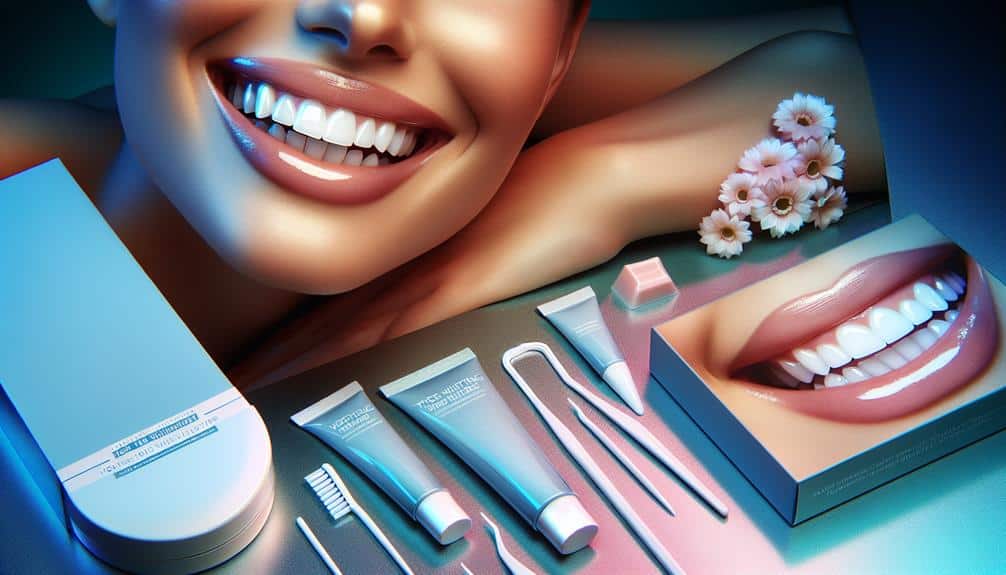Discover effective overnight teeth whitening treatments for a brighter smile. Try whitening strips with hydrogen peroxide for enamel lightening. Consider hydrogen peroxide gel application for even distribution and noticeable results. Protect your gums with proper technique and safety precautions. For natural options, explore charcoal's benefits for stain removal and LED light treatments for shorter sessions. These proven methods can enhance your smile overnight, providing noticeable results for a brighter appearance.
Key Points
- Whitening strips with hydrogen peroxide for enamel lightening.
- Charcoal teeth whitening removes surface stains effectively.
- LED light treatments accelerate stain breakdown for brightness.
- Natural remedies like baking soda and coconut oil aid in whitening.
- Overnight whitening toothpaste with fluoride and hydrogen peroxide.
Whitening Strips Overview
If you're looking for a convenient and effective way to brighten your smile, whitening strips offer a popular at-home solution. When considering strip effectiveness, these products generally contain a gel with bleaching agents like hydrogen peroxide. The gel application is designed to adhere to your teeth, allowing the active ingredients to break down stains and lighten the enamel.
When following the manufacturer's instructions carefully is crucial to prevent any potential gum irritation or enamel damage. Some whitening strips also boast charcoal benefits, claiming that charcoal can help absorb impurities and stains from the teeth. While charcoal may have some benefits in absorbing certain substances, more research is needed to determine its efficacy in teeth whitening.
Hydrogen Peroxide Gel Application
When applying hydrogen peroxide gel for teeth whitening, make sure you follow the recommended technique to evenly distribute the gel.
Safety precautions are crucial, so protect your gums and soft tissues from exposure to the gel to prevent irritation or damage.
Be mindful of the duration and frequency of gel application to achieve best results without causing harm to your teeth or oral health.
Gel Application Technique
For effective overnight teeth whitening, properly applying hydrogen peroxide gel is crucial to achieving desired results. Start by brushing your teeth with a fluoride toothpaste to guarantee a clean surface.
Next, apply a thin layer of hydrogen peroxide gel onto the front surface of your teeth using a small brush or applicator. Make sure to avoid applying the gel on your gums to prevent irritation. Gel application tips include evenly distributing the gel on each tooth and avoiding swallowing any excess gel.
Once applied, leave the gel on overnight as per the product instructions for best whitening effects. Remember, consistency in gel application technique is key to seeing noticeable results in the brightness of your smile.
Safety Precautions for Hydrogen Peroxide
In order to guarantee safe and effective hydrogen peroxide gel application for overnight teeth whitening, understanding and implementing proper safety precautions is essential. Here are some safety tips to keep in mind:
- Protect Your Gums: Apply a thin layer of petroleum jelly to your gums before applying the gel to prevent irritation.
- Use the Recommended Concentration: Stick to the hydrogen peroxide concentration recommended by the product to avoid potential damage.
- Avoid Swallowing: Rinse your mouth thoroughly after whitening to prevent ingesting the product.
- Consider Alternative Products: If you have sensitive teeth or gums, consider using alternative products like carbamide peroxide for a gentler whitening experience.
Duration and Frequency
To achieve the best results with hydrogen peroxide gel for teeth whitening, it's important to adhere to the recommended duration and frequency of application.
For overnight results and long-term effects, it's typically advised to use the hydrogen peroxide gel daily for a specified period.
However, once the desired level of whitening is achieved, shifting to a weekly maintenance schedule can help sustain the brightness of your smile over time.
Daily use of hydrogen peroxide gel can effectively target surface stains and discoloration, while incorporating weekly applications guarantees that the whitening effects are maintained for the long term.
Charcoal Teeth Whitening Benefits
Utilize the natural absorbent properties of activated charcoal to effectively enhance your teeth whitening regimen. Activated charcoal offers several benefits when it comes to teeth whitening:
- Charcoal Toothpaste Benefits:
Charcoal toothpaste is known for its ability to remove surface stains and toxins from the teeth, resulting in a brighter smile.
- Whitening Masks:
Charcoal-based whitening masks can help draw out impurities, toxins, and stains from the teeth, promoting a whiter appearance.
- Activated Charcoal Benefits:
Activated charcoal has adsorptive properties that bind to compounds causing stains on the teeth, aiding in their removal.
- Whitening Scrubs:
Charcoal-infused whitening scrubs can gently exfoliate the teeth, buffing away stains and revealing a whiter enamel underneath.
Overnight Whitening Tray Usage
Enhance your teeth whitening regimen by utilizing overnight whitening trays for a more effective and convenient treatment option. Custom trays are designed to fit your teeth precisely, ensuring that the whitening gel stays in place and maximizes contact with your teeth. This customized fit helps in preventing the gel from being diluted by saliva and spreading to the gums, reducing the risk of irritation.
Using overnight whitening trays can lead to top-notch results as the extended contact time allows the whitening gel to work consistently on your teeth throughout the night. The gradual yet continuous treatment provided by these trays can result in a more thorough whitening effect compared to shorter treatments.
To achieve the best results with overnight whitening trays, it's essential to follow the instructions provided by your dentist or the product manufacturer carefully. Consistency in usage and adherence to recommended treatment durations are key to obtaining the desired level of whitening while maintaining the health of your teeth and gums.
Enamel-Safe Whitening Pens
Consider incorporating enamel-safe whitening pens into your dental care routine for a convenient and gentle approach to brightening your smile. These pens offer quick application and enamel protection, making them a popular choice for those looking to enhance their smile effortlessly.
Here are some key benefits of enamel-safe whitening pens:
- Precision Application: Enamel-safe whitening pens allow you to target specific areas of your teeth with precision, ensuring an even application and avoiding contact with your gums.
- Convenience: With their sleek and compact design, whitening pens are easy to carry around, making them perfect for on-the-go touch-ups whenever needed.
- No Sensitivity: Many enamel-safe whitening pens are formulated to minimize tooth sensitivity, allowing you to achieve a brighter smile without discomfort.
- Effective Results: Despite their gentle nature, whitening pens can deliver noticeable results over time when used consistently as part of your oral care routine.
LED Light Accelerated Whitening
When considering teeth whitening options, LED light accelerated whitening stands out as a popular choice.
The benefits of using LED light include its ability to enhance the whitening process and deliver faster results.
This method is known to be safe, effective, and can help achieve a brighter smile overnight.
Light Activated Whitening
To accelerate the whitening process, LED light is commonly used in light-activated whitening treatments. The dental light technology enhances the effectiveness of accelerated whitening techniques, providing you with a brighter smile overnight.
Here are some key features of light-activated whitening:
- Quick: LED light speeds up the whitening process.
- Effective: Enhances the whitening gel's performance.
- Convenient: Can be done at home or in a dental office.
- Safe: LED light is non-invasive and gentle on your teeth.
With the combination of LED light and whitening agents, you can achieve noticeable results in a short amount of time, making light-activated whitening a popular choice for those seeking fast and efficient teeth whitening solutions.
Benefits of LED
Applying LED light in teeth whitening treatments can greatly enhance the speed and effectiveness of the whitening process, giving you visible results in a shorter timeframe. LED light benefits the whitening process by accelerating the chemical reaction of whitening agents, leading to quicker and more noticeable results.
Research has shown the effectiveness of LED light in enhancing the penetration of whitening agents into the enamel, resulting in a more thorough whitening effect. Moreover, LED light is considered safe for dental use, as it emits low levels of heat and UV light, minimizing the risk of sensitivity or damage to the teeth and surrounding tissues.
Safe and Effective
Utilizing LED light in teeth whitening treatments accelerates the whitening process, ensuring safe and effective results in a shorter period. LED light accelerates the breakdown of stains on your teeth, leading to a brighter smile with reduced risks.
- LED light targets stains effectively.
- Shorter treatment times with LED.
- Minimal sensitivity with LED treatments.
- LED light is safe for at-home use.
LED light accelerated whitening is a popular choice due to its convenience and proven effectiveness. Unlike some home remedies or DIY solutions, LED treatments offer a reliable and controlled method to whiten teeth without causing harm. Consider LED light accelerated whitening for a brighter, safer smile.
Natural Whitening Remedies
Consider incorporating natural ingredients like baking soda or activated charcoal into your teeth whitening routine for a more gentle approach. While lemon juice remedies and baking soda treatments are popular, it's crucial to use them cautiously. Lemon juice's acidity can erode enamel, so it's advisable to mix it with water and use it sparingly. Baking soda, on the other hand, can help scrub away surface stains but shouldn't be used excessively due to its abrasive nature.
Another natural method to explore is coconut oil pulling. This involves swishing coconut oil around in your mouth to remove bacteria and promote oral health. While it may not provide instant whitening effects, consistent use can contribute to a brighter smile over time. Additionally, turmeric paste application is gaining attention for its potential whitening properties. Turmeric is known for its anti-inflammatory and antimicrobial benefits, which could aid in maintaining healthy gums and teeth.
Incorporating these natural remedies into your dental care routine can complement professional treatments and promote a whiter smile in the long run.
Overnight Whitening Toothpaste
When seeking overnight teeth whitening effects, consider toothpaste ingredients like hydrogen peroxide or baking soda for their whitening properties.
Make sure you brush your teeth using the right technique, focusing on all tooth surfaces for the best efficacy.
Remember that the frequency of using whitening toothpaste is important – follow the recommended guidelines to avoid damaging your enamel.
Toothpaste Ingredients for Whitening
For effective overnight whitening toothpaste, carefully select ingredients known to combat stains and brighten your teeth while you sleep. When choosing a toothpaste for overnight whitening, look for the following key ingredients:
- Baking soda: Known for its abrasive properties, baking soda helps to scrub away surface stains gently.
- Fluoride: This ingredient not only helps in preventing cavities but also strengthens enamel, making your teeth more resistant to stains.
- Hydrogen peroxide: A common whitening agent that can penetrate the enamel to bleach the discolored molecules inside your teeth.
- Potassium nitrate: Helps in reducing sensitivity, which can be common when using whitening toothpaste.
Selecting a toothpaste with these ingredients can enhance your overnight whitening experience effectively.
Brushing Technique for Efficacy
To maximize the efficacy of your overnight whitening toothpaste, make sure you brush your teeth using gentle circular motions for thorough coverage. This technique guarantees that the whitening ingredients in the toothpaste are evenly distributed across all surfaces of your teeth, maximizing their contact and potential benefits.
Additionally, incorporating a proper flossing technique before brushing can help remove plaque and debris, allowing the whitening toothpaste to work more effectively. Choose a mouthwash that complements the whitening toothpaste to enhance the overall whitening results.
Frequency of Toothpaste Use
Maximize the benefits of your overnight whitening toothpaste by ensuring you use it consistently at the recommended frequency for best results. Proper toothpaste application and brushing frequency are vital for achieving a brighter smile. Follow these tips to make the most of your overnight whitening toothpaste:
- Apply a pea-sized amount of toothpaste on a dry toothbrush.
- Brush your teeth gently in circular motions for at least two minutes.
- Use the overnight whitening toothpaste every night before bed for the best results.
- Avoid rinsing your mouth after brushing to allow the toothpaste to work overnight.
Consistent use and correct application of your overnight whitening toothpaste will help you achieve a radiant smile.
Whitening Mouthwash Effects
Using a whitening mouthwash consistently can contribute to enhancing the brightness of your teeth over time. The benefits of using a whitening mouthwash go beyond just freshening your breath; they can also help in removing surface stains on your teeth. The effectiveness of a whitening mouthwash lies in its formulation, typically containing hydrogen peroxide or other whitening agents that can penetrate the enamel to lighten the teeth. For best results, it's recommended to use the mouthwash as directed, usually twice a day after brushing your teeth.
Results from using a whitening mouthwash may vary depending on factors such as the individual's starting tooth shade, the frequency of use, and the specific formulation of the mouthwash. Generally, you can expect gradual improvements in the whiteness of your teeth with regular and consistent use. However, for more significant whitening effects, combining a whitening mouthwash with other whitening treatments may be necessary. Remember to consult with your dentist before starting any new whitening regimen to make sure it's appropriate for your dental health.
Professional Whitening Gel Kits
When considering professional whitening gel kits, it's crucial to understand their efficacy and application for achieving a brighter smile. These kits typically contain a higher concentration of whitening agents than over-the-counter products, offering more effective results. Here are some key points to keep in mind:
- Whitening gel effectiveness: Professional whitening gel kits are formulated to penetrate deeper into the enamel, effectively lifting stubborn stains and discoloration for a noticeably brighter smile.
- Gel application tips: To maximize the effectiveness of the gel, make sure that your teeth are clean and dry before applying the product. Use the recommended amount of gel per application to avoid sensitivity issues.
- Consistency is key: For best results, follow the recommended treatment schedule consistently. Skipping applications or extending the intervals between treatments can hinder the whitening process.
- Consult a professional: If you experience any sensitivity or discomfort during the whitening process, seek advice from a dental professional to avoid potential complications.
Frequently Asked Questions
Can Overnight Teeth Whitening Treatments Cause Sensitivity in Teeth?
Using overnight teeth whitening treatments can potentially cause sensitivity in your teeth. These products may lead to temporary discomfort due to their strong bleaching agents. Prolonged use could result in enamel damage, so consult a dentist for guidance.
Are There Any Potential Risks or Side Effects Associated With Using Overnight Teeth Whitening Products?
When using overnight teeth whitening products, remember potential risks like increased sensitivity. Side effects can include gum irritation. Despite the promise of quick results, it's important to weigh these factors before pursuing treatment for a brighter smile.
How Long Does It Typically Take to See Noticeable Results From Overnight Teeth Whitening Treatments?
Typically, you can expect to see noticeable results from overnight teeth whitening treatments within a few days to a week. Long term effects vary. To maintain results, follow proper dental care and consider professional consultation.
Can Overnight Teeth Whitening Treatments Be Used on Dental Work Such as Crowns or Veneers?
When it comes to dental work like crowns or veneers, overnight teeth whitening treatments have limitations. Expectations for overnight results should be managed accordingly. Consult your dentist for the best advice tailored to your specific situation.
Are There Any Specific Dietary or Lifestyle Recommendations to Follow While Using Overnight Teeth Whitening Treatments for Best Results?
To achieve best results with overnight teeth whitening treatments, focus on healthy eating and lifestyle changes. Maintain a consistent oral hygiene routine for optimum outcomes. These practices complement the whitening process and promote overall dental health.




